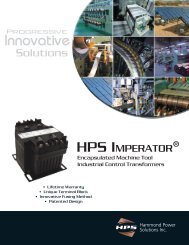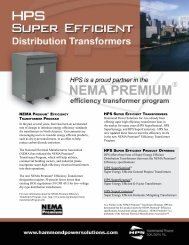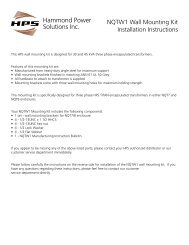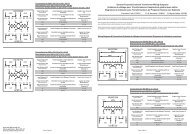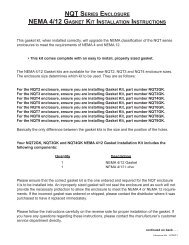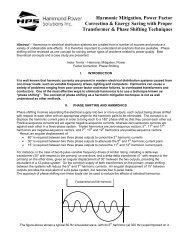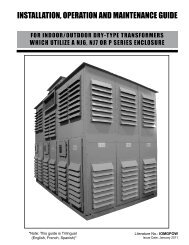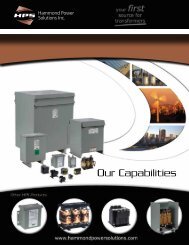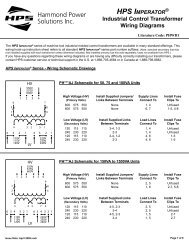Hammond Power Solutions | Annual Report 2010
Hammond Power Solutions | Annual Report 2010
Hammond Power Solutions | Annual Report 2010
You also want an ePaper? Increase the reach of your titles
YUMPU automatically turns print PDFs into web optimized ePapers that Google loves.
Notes to Consolidated Financial Statements<br />
Years ended December 31, <strong>2010</strong> and 2009 (tabular amounts in thousands of dollars)<br />
Notes to Consolidated Financial Statements<br />
Years ended December 31, <strong>2010</strong> and 2009 (tabular amounts in thousands of dollars)<br />
7. Bank operating lines of credit:<br />
The Company has a U.S. $40,000,000 revolving credit facility that expires on September 30, 2012, consisting of a U.S. $25,000,000 (or Canadian<br />
dollar equivalent) revolving credit line, and a U.S. $15,000,000 (or Canadian dollar equivalent) delayed draw revolving credit line facility, which<br />
are both unsecured. Interest on the revolving credit lines is dependent on certain financial ratios and ranges from Canadian bank prime rate minus<br />
0.50% to Canadian bank prime rate for the Canadian dollar denominated revolving credit lines or, if designated, the bank’s CDOR rate plus 1.25%<br />
to 1.75% and from U.S. base rate minus 1.00% to U.S. base rate minus 1.50% for the U.S. dollar denominated revolving credit lines or, if designated,<br />
the bank’s LIBOR rate plus 1.25% to 1.75%. As at December 31, <strong>2010</strong>, the Canadian dollar equivalent outstanding under the Canadian revolving<br />
credit line and the U.S. revolving credit line was $1,034,000 and $413,000 respectively (2009 – $393,000 and $3,632,000).<br />
Under the terms of the facility, the Company pays an unused line fee at rates ranging from 0.15% to 0.25% calculated monthly in arrears, on<br />
the average daily un-borrowed portion of the credit facility.<br />
8. Long-term debt:<br />
During the year the Company was awarded an unsecured, non-interest bearing credit facility of up to $1,495,000 from the Canadian Federal<br />
Economic Development Agency for Southern Ontario for the expansion of the Guelph manufacturing facility. As at December 31, <strong>2010</strong>, $395,000<br />
had been advanced to HPS, which is payable over 5 years in equal monthly installments commencing March 1, 2011.<br />
9. Income taxes:<br />
The Company’s provision for income tax is comprised of the following:<br />
<strong>2010</strong> 2009<br />
Income taxes based on a combined Canadian federal and<br />
provincial income tax rate of 41.00% (2009 – 42.00%) $ 6,054 $ 6,750<br />
Increase (decrease) in income taxes resulting from:<br />
Reduced rate for active business and manufacturing and processing (1,180) (963)<br />
Lower income tax rate on income of foreign subsidiaries (345) (785)<br />
Foreign exchange translation loss (gain) 466 1,762<br />
Permanent tax differences 118 91<br />
Others (56) (414)<br />
Income tax expense $ 5,057 $ 6,441<br />
The tax effect of temporary differences that give rise to significant portions of the future tax assets and future tax liabilities at December 31 are<br />
presented below:<br />
Current future tax asset:<br />
<strong>2010</strong> 2009<br />
Inventory provisions $ 278 $ 265<br />
Accounts receivable, allowance for doubtful accounts 23 86<br />
Investment tax credits (1) (3)<br />
Accounts payable and accrued liabilities not currently deductible 27 295<br />
$ 574 $ 643<br />
Current future tax liability:<br />
<strong>2010</strong> 2009<br />
Deductible subsequent pension contributions $ 120 $ 104<br />
Inventory provision (66) (61)<br />
Investment tax credits 44 19<br />
Unrealized gains on forward contracts 287 133<br />
Accounts receivable, allowance for doubtful accounts – (15)<br />
Accounts payable and accrued liabilities not currently deductible (59) –<br />
Long-term future tax asset:<br />
$ 326 $ 180<br />
Property, plant and equipment – differences in net book value and undepreciated capital cost $ 12 $ 42<br />
Long-term future tax liability:<br />
10. Share capital:<br />
(a)<br />
(b)<br />
Property, plant and equipment – differences in net book value and undepreciated capital cost $ 1,461 $ 1,157<br />
Intangible assets – differences in net book value and undepreciated capital cost 77 86<br />
Accrued liabilities and environmental reserve not currently deductible (73) (86)<br />
$ 1,465 $ 1,157<br />
Authorized:<br />
Unlimited number of special shares, discretionary dividends, non-voting, redeemable and retractable;<br />
Unlimited number of Class A subordinate voting shares;<br />
Unlimited number of Class B common shares with four votes per share, convertible into Class A subordinate voting shares on a one-for-one<br />
basis. <strong>Annual</strong> dividends on the Class B common shares may not exceed the annual dividends on the Class A subordinate voting shares.<br />
Issued:<br />
<strong>2010</strong> 2009<br />
8,804,624 Class A subordinate voting shares (2009 – 8,839,826) $ 12,961 $ 12,952<br />
2,778,300 Class B common shares (2009 – 2,778,300) 7 7<br />
11,582,924 Total Class A and B shares $ 12,968 $ 12,959<br />
During the year, 16,000 (2009 – 6,000) Class A subordinate voting shares were issued upon exercise of stock options, resulting in cash<br />
proceeds of $55,000 (2009 – $36,000) and a transfer of $28,000 (2009 – $20,000) from contributed surplus. Additionally, the Company purchased<br />
and cancelled 51,202 (2009 – 108,174) Class A shares under a normal course issuer bid at a cost of $584,000 (2009 – $915,000) of which<br />
$74,000, $3,000, and $507,000 (2009 – $158,000, $6,000 and $751,000) was applied against share capital, contributed surplus and retained<br />
earnings respectively. The normal course issuer authorized the repurchase of up to 400,000 Class A shares. Shares acquired under the normal course<br />
issuer bid were cancelled upon purchase. The normal course issuer bid expired on July 20, <strong>2010</strong>.<br />
(c)<br />
Stock option plan:<br />
The Company uses a stock option plan to attract and retain key employees, officers and directors. The shareholders have approved a maximum of<br />
800,000 Class A subordinate voting shares for issuance under the Stock Option Plan, with the maximum reserved for issuance to any one person<br />
at 5% of the Class A shares outstanding calculated immediately prior to the time of the grant. As per the Stock Option Plan, the Board of Directors<br />
may, at its sole discretion, determine the time during which the Options shall vest and the method of vesting, or that no vesting restriction shall<br />
exist. The stock option exercise price is the price of the Company’s common shares on the Toronto Stock Exchange at closing for the day prior to the<br />
40 NOTES TO CONSOLIDATED FINANCIAL STATEMENTS<br />
<strong>Hammond</strong> <strong>Power</strong> <strong>Solutions</strong> | <strong>Annual</strong> <strong>Report</strong> 41



